The anatomy of a hedge
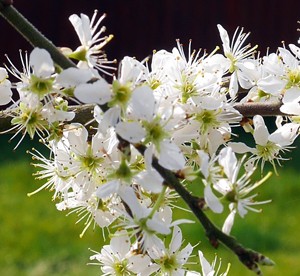
A hedge or hedgerow is made up of a number of parts or habitats. It may offer
- the main bulk of the hedge - that is the trees and shrubs
- the bottom or base of the hedge - which is a strip of land with its own species, a mix of annuals and perennials, some herbaceous others more woody. The base of the hedge can be quite variable, sometimes being narrow and light, or wide and dark (perhaps, supporting a badger or rabbit run)
- a bank that supports the hedge and there may even be an associated ditch (a different habitat in itself)
- a border or verge - an area of adjacent land which may be arable, pastoral or man-made in nature e.g. highway or managed in some way - mowed, grazed or sprayed.
Animals may move between these areas / habitats. For example, a bird such as a yellow hammer might feed on the border or verge (perhaps a field margin), nest near the 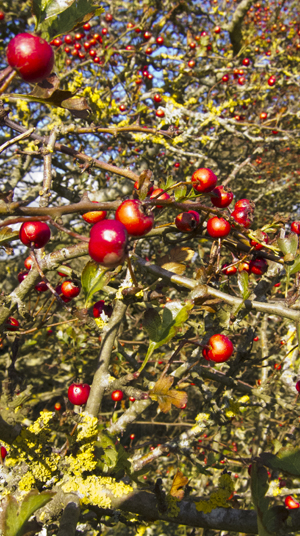 bottom of the hedge, hide in the shrubs from predators, whilst making use of the trees to perch / sing / establish or announce its territory. The yellow hammer tends to nest on or close to the ground in dense, relatively short hedges, also favouring field margins and the edges of woodlands. A hawthorn hedge is a good home for tree sparrows (cousins of the house sparrow); the dense prickles provide a home and protection from predators, such as sparrowhawks.
bottom of the hedge, hide in the shrubs from predators, whilst making use of the trees to perch / sing / establish or announce its territory. The yellow hammer tends to nest on or close to the ground in dense, relatively short hedges, also favouring field margins and the edges of woodlands. A hawthorn hedge is a good home for tree sparrows (cousins of the house sparrow); the dense prickles provide a home and protection from predators, such as sparrowhawks.
The main body / bulk of a hedge is generally formed from a limited number of species - notably hawthorn, blackthorn, hazel, ash, beech and gorse (if the soil is dry and sandy). However, hawthorn and blackthorn have been the most frequently used species. The use of thorny species goes back a long way; they were used extensively following the various enclosure acts. Hawthorn was also often planted along the new railway lines that spread across the country in the 19th century.
The use of hawthorn depended upon a number of its ‘qualities’, it
- was stock proof
- was easy to lay
- readily produces side shoots, giving a dense hedge quickly
- is hardy (withstands cold), tolerant of dry or indeed wet soils,
- is resistant to disease (except fire flight, a bacterial disease that arrived from the USA circa 1957)
- is long lived
Hawthorn is also known as Whitethorn because of its white Spring flowers. These flowers are a pleasure to see but their smell is not as sweet. They produce trimethylamine - an odour associated with rotting fish. Hawthorn is also known as the May Tree or sometimes 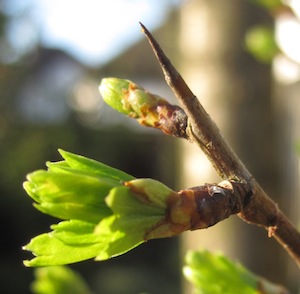 Quickthorn. The term quickthorn takes it origin from the saying “the quick and the dead” referring to the fact that hawthorn forms a living hedge as opposed to one created from cut twigs and branches (i.e.a dead hedge). The common hawthorn (Crataegus monogyna) is found an understorey tree of woodland and has a wide range in the U.K. The Midland Hawthorn is confined to more southern areas. The two species readily hybridise. The leaves of the common hawthorn are deeply divided and the berries have only have one pip / seed.
Quickthorn. The term quickthorn takes it origin from the saying “the quick and the dead” referring to the fact that hawthorn forms a living hedge as opposed to one created from cut twigs and branches (i.e.a dead hedge). The common hawthorn (Crataegus monogyna) is found an understorey tree of woodland and has a wide range in the U.K. The Midland Hawthorn is confined to more southern areas. The two species readily hybridise. The leaves of the common hawthorn are deeply divided and the berries have only have one pip / seed.
Nowadays, many plants of hawthorn are sourced from abroad - particularly Germany and Hungary. Plants of local provenance tend to fare better than those from Continental Europe. With locally sourced plants, leaf emergence and bud burst occur at the ‘right’ time, thereby avoiding frost damage and these events are synchronous with associated insect populations.
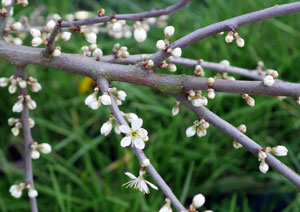 The Blackthorn (Prunus spinosa) also has white flowers - like hawthorn, but these appear before the leaves (see adjacent image). The white flowers contrast markedly with the dark brown, almost black stems and bark. Like hawthorn, it has a wide distribution in the U.K (apart from the Highlands). Blackthorn tolerates most soils though it is not so good on acidic soils. It was often planted in hedges - especially in the South West. The plant has significant and abundant spines, which makes it very useful in creating a stock-proof hedge. It is somewhat smaller than the hawthorn and its cuttings / trimmings were very useful in the creation of a dead hedges, as its twigs last longer than those of whitethorn. The fruit of blackthorn is the sloe - often used in the making of sloe gin. The blackthorn is host to a number of butterfly and moth species e.g. brown hairstreak / magpie moth).
The Blackthorn (Prunus spinosa) also has white flowers - like hawthorn, but these appear before the leaves (see adjacent image). The white flowers contrast markedly with the dark brown, almost black stems and bark. Like hawthorn, it has a wide distribution in the U.K (apart from the Highlands). Blackthorn tolerates most soils though it is not so good on acidic soils. It was often planted in hedges - especially in the South West. The plant has significant and abundant spines, which makes it very useful in creating a stock-proof hedge. It is somewhat smaller than the hawthorn and its cuttings / trimmings were very useful in the creation of a dead hedges, as its twigs last longer than those of whitethorn. The fruit of blackthorn is the sloe - often used in the making of sloe gin. The blackthorn is host to a number of butterfly and moth species e.g. brown hairstreak / magpie moth).
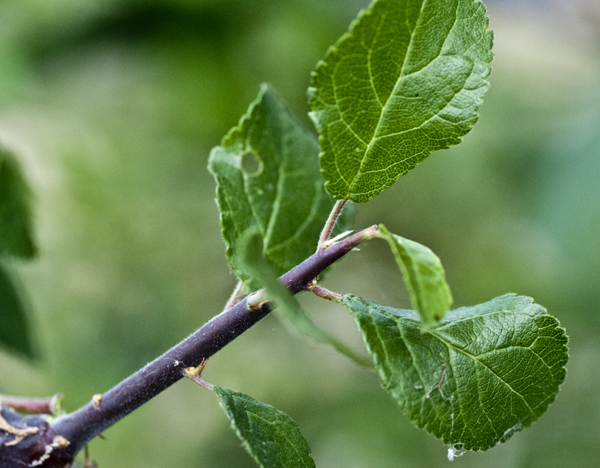
Spine of Blackthorn
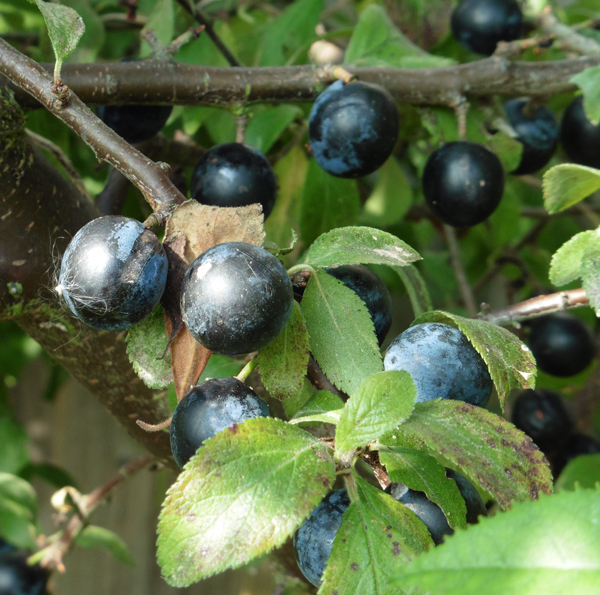
Sloes on Blackthorn
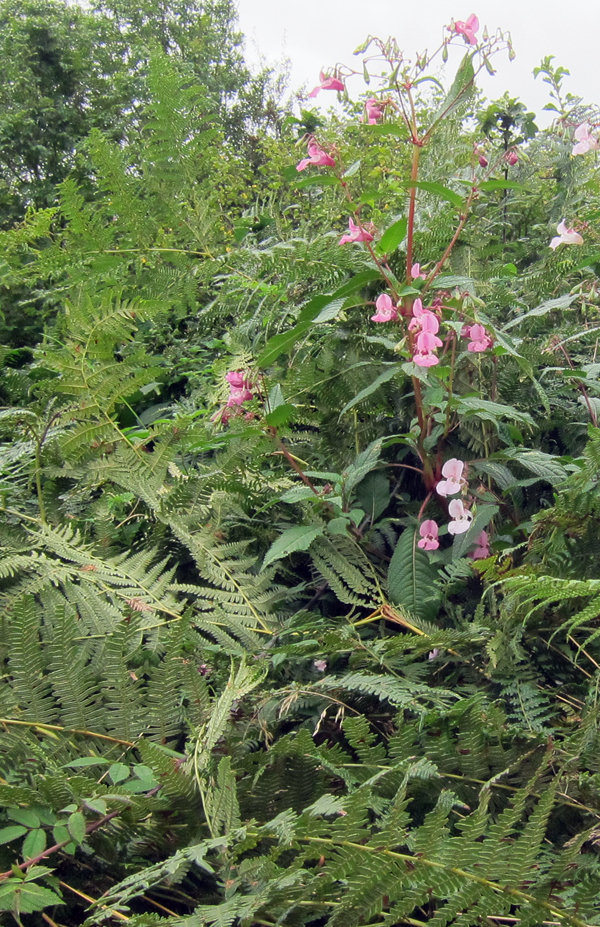
Himalayan Balsam in hedge*
Comments are closed for this post.
Discussion
In my time in Countryside Conservation work, Himalayan Balsam, as with Rhododendron, was regarded as an unwelcome introduction from a very different habitat, which has no known control species in our climate, therefore out-competes and ‘bullies’ the native species and we used to have whole days devoted to trying to knock them all back.

Yes, see http://www.woodlands.co.uk/blog/flora-and-fauna/himalayan-balsam-nemesis-is-nigh/
Blogs
4 October, 2016